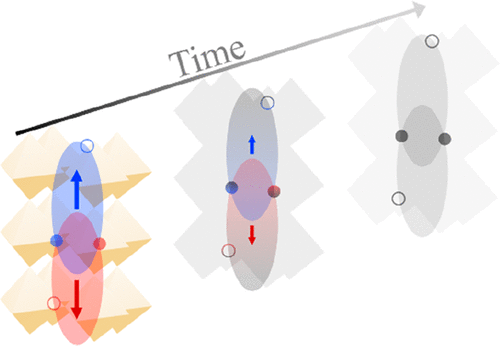当前位置:
X-MOL 学术
›
Nano Lett.
›
论文详情
Our official English website, www.x-mol.net, welcomes your feedback! (Note: you will need to create a separate account there.)
How Exciton Interactions Control Spin-Depolarization in Layered Hybrid Perovskites.
Nano Letters ( IF 10.8 ) Pub Date : 2020-06-23 , DOI: 10.1021/acs.nanolett.0c00867 Sean A Bourelle 1 , Ravichandran Shivanna 1 , Franco V A Camargo 2 , Soumen Ghosh 2 , Alexander J Gillett 1 , Satyaprasad P Senanayak 1, 3 , Sascha Feldmann 1 , Lissa Eyre 1, 4 , Arjun Ashoka 1 , Tim W J van de Goor 1 , Haralds Abolins 1 , Thomas Winkler 1 , Giulio Cerullo 2 , Richard H Friend 1 , Felix Deschler 4
Nano Letters ( IF 10.8 ) Pub Date : 2020-06-23 , DOI: 10.1021/acs.nanolett.0c00867 Sean A Bourelle 1 , Ravichandran Shivanna 1 , Franco V A Camargo 2 , Soumen Ghosh 2 , Alexander J Gillett 1 , Satyaprasad P Senanayak 1, 3 , Sascha Feldmann 1 , Lissa Eyre 1, 4 , Arjun Ashoka 1 , Tim W J van de Goor 1 , Haralds Abolins 1 , Thomas Winkler 1 , Giulio Cerullo 2 , Richard H Friend 1 , Felix Deschler 4
Affiliation

|
Using circularly polarized broadband transient absorption, time-resolved circular photoluminescence, and transient Faraday rotation spectroscopy, we report that spin-dependent interactions have a significant impact on exciton energies and spin depolarization times in layered Ruddlesden–Popper hybrid metal-halide perovskites. In BA2FAPb2I7, we report that room-temperature spin lifetimes are largest (3.2 ps) at a carrier density of ∼1017 cm–3 with increasing depolarization rates at higher exciton densities. This indicates that many-body interactions reduce spin-lifetimes and outcompete the effect of D’yakonov-Perel precessional relaxation that has been previously reported at lower carrier densities. We further observe a dynamic circular dichroism that arises from a photoinduced polarization in the exciton distribution between total angular momentum states. Our findings provide fundamental and application relevant insights into the spin-dependent exciton–exciton interactions in layered hybrid perovskites.
中文翻译:

激子相互作用如何控制分层混合钙钛矿中的自旋去极化。
使用圆偏振宽带瞬态吸收,时间分辨的圆形光致发光和瞬态法拉第旋转光谱,我们报告了自旋依赖性相互作用对Ruddlesden-Popper混合金属卤化物钙钛矿中激子能量和自旋去极化时间有重大影响。在BA 2 FAPb 2 I 7中,我们报道了室温自旋寿命在载流子密度约为10 17 cm –3时最大(3.2 ps)。在更高的激子密度下,去极化率会增加。这表明,多体相互作用减少了自旋寿命,并胜过了以前报道的载流子密度较低的D'yakonov-Perel进动弛豫的影响。我们进一步观察到动态圆二色性,它是由总角动量态之间的激子分布中的光致极化引起的。我们的发现为分层杂化钙钛矿中自旋相关的激子-激子相互作用提供了基础和应用方面的见解。
更新日期:2020-08-12
中文翻译:

激子相互作用如何控制分层混合钙钛矿中的自旋去极化。
使用圆偏振宽带瞬态吸收,时间分辨的圆形光致发光和瞬态法拉第旋转光谱,我们报告了自旋依赖性相互作用对Ruddlesden-Popper混合金属卤化物钙钛矿中激子能量和自旋去极化时间有重大影响。在BA 2 FAPb 2 I 7中,我们报道了室温自旋寿命在载流子密度约为10 17 cm –3时最大(3.2 ps)。在更高的激子密度下,去极化率会增加。这表明,多体相互作用减少了自旋寿命,并胜过了以前报道的载流子密度较低的D'yakonov-Perel进动弛豫的影响。我们进一步观察到动态圆二色性,它是由总角动量态之间的激子分布中的光致极化引起的。我们的发现为分层杂化钙钛矿中自旋相关的激子-激子相互作用提供了基础和应用方面的见解。



























 京公网安备 11010802027423号
京公网安备 11010802027423号